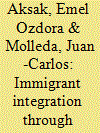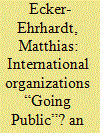| Srl | Item |
| 1 |
ID:
132525


|
|
|
|
|
| Publication |
2014.
|
| Summary/Abstract |
This research focuses on the European Union's (EU) public relations and public diplomacy efforts for immigrant integration. It uncovers the relationship between the EU and leaders of Turkish associations in Brussels, Belgium. In-depth interviews with Turkish association leaders reveal the way they see themselves and the Turkish diaspora, how they reflect on their national identities, and their understanding of EU public diplomacy and public relations strategies. The communication strategies Turkish associations use to gather information about immigrant integration and their opinions on EU communication strategies are also studied. In addition, the research investigates whether two-way communication exists between the Turkish associations and the EU, and unveils the strategic communication and public relations strategies the Turkish diaspora uses to influence public policy and to engage in lobbying.
|
|
|
|
|
|
|
|
|
|
|
|
|
|
|
|
| 2 |
ID:
163270


|
|
|
|
|
| Summary/Abstract |
The last few decades have seen a dramatic increase in the public communication efforts of international organizations (IOs). They target an expanding audience, including journalists, experts, activists, and citizens. Their communication departments have grown to more effectively produce and disseminate messages, evaluate their impact, and develop long-term communication strategies. I examine this trend for forty-eight IOs between 1950 and 2015. Based on an event history analysis of structural reforms, I argue that two causal mechanisms most consistently explain why IOs go public: First, normative change toward greater institutional transparency encourages the democratic membership of IOs to push for reforms in order to improve the provision of public information on IO decisions and policy programs. Second, public protest and scandals substantially increase organizational demands for self-legitimation. As a result, IOs reformed communication in order to more effectively generate public support. However, I find limited evidence that IO mandates to promote social change—by teaching norms and knowledge—can account for observed reforms to their communication structures.
|
|
|
|
|
|
|
|
|
|
|
|
|
|
|
|
| 3 |
ID:
139010


|
|
|
|
|
| Summary/Abstract |
This article defines and assesses the ideal-type of the radical criminal as the analytical framework for a comparative qualitative study of Mexican religious drug cartels and Australian outlaw motorcycle gangs and concludes that radical criminals operate in both weak and failed states and stable democracies. The article participates in the wider discussion concerning the existence (and the features) of a grey area between criminal and political violence, through the lens of the radical criminal ideal-type.
|
|
|
|
|
|
|
|
|
|
|
|
|
|
|
|